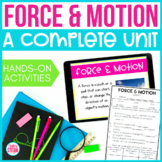Force and Motion Assessment | PowerPoint and Quiz
- Zip
- Google Apps™

What educators are saying
Also included in
- Never skip another science lesson! This 3rd grade science bundle for distance learning is the perfect solution for squeezing in a quick science lesson whether you're teaching face-to-face, hybrid, or distance learning. This resource is NOW available in PowerPoint, Google Slides, a paper quiz, and GoPrice $17.00Original Price $33.00Save $16.00
- Are you looking for a way to squeeze in science in your already busy schedule? This force and motion unit has all the things you need to keep your students engaged and learning! Here's what you'll get: 7 Reading Passages (digital and print)7 Worksheets (print only)6 PowerPoint Lessons 6 Quizzes (digPrice $12.00Original Price $21.49Save $9.49
Description
Never skip another science lesson! These force and motion PowerPoints and quizzes are the perfect solutions for squeezing in quick science lessons. This includes Google Forms, Google Slides, and paper assessments!
Save even more money when you purchase the Science PowerPoint and Quizzes BUNDLE!
This unit includes the following topics:
- Force and Motion
- Speed and Direction
- Push and Pull
- Types of Forces
- Gravity
- Newton's Laws
These force and motion lessons and assessments are perfect for 3rd grade!
Each PowerPoint lesson includes:
- PowerPoint Quiz
- High-quality pictures
- Rich content
These simple layouts give students small chunks of information so they can easily understand it.
Each Assessment includes:
- 8-12 questions each.
- Two quizzes per page to save paper!
- Answer key saving you time grading!
- Easy grader for a quick reference
These are mega time-saving assessments!
Question Types Include:
- Fill in the Blank (with Word Bank)
- List Examples
- Circle the Best Choice
- Illustration
Learn more about how these helped me in my classroom by clicking here.
Please note that each file is in a zip file. Each file contains a hyperlinked pdf with Google Slides and Google Forms, individual PowerPoints, paper quizzes, and instructions.
Hey, let's get connected!
It pays to follow Simply STEAM! All resources are at 50% off for the first 24 hours. Please click the ☆ above to save on new resources!
Don't forget to rate this resource for your FREE TpT credits!







